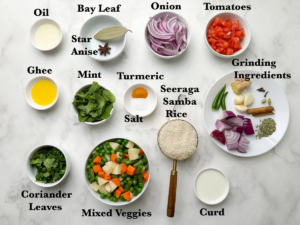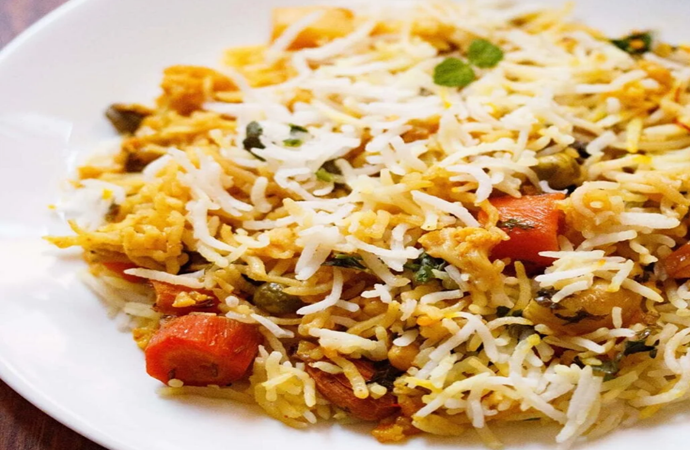Contents
- 1 What is Veg Biryani?
- 2 Ingredients for Veg Biryani
- 3
- 4 Preparing the Rice for Veg Biryani
- 5 Cooking the Vegetable Mixture
- 6 Layering the Veg Biryani
- 7 Dum Cooking Veg Biryani
- 8 Serving and Garnishing Veg Biryani
- 9 Variations of Veg Biryani
- 10 Tips for a Perfect Veg Biryani
- 11 Health Benefits of Veg Biryani
- 12 Conclusion
- 13 FAQ
- 13.1 What is Veg Biryani?
- 13.2 What are the key ingredients for Veg Biryani?
- 13.3 How do I prepare the rice for Veg Biryani?
- 13.4 How do I cook the vegetable mixture for Veg Biryani?
- 13.5 How do I layer the Veg Biryani?
- 13.6 What is the traditional method of cooking Veg Biryani?
- 13.7 How can I garnish and serve Veg Biryani?
- 13.8 Can I customize the Veg Biryani recipe?
- 13.9 What are some tips for making a perfect Veg Biryani?
- 13.10 Are there any health benefits to eating Veg Biryani?
If you are looking for a delicious and healthy meal that can be made quickly and easily at home, then try this easy veg biryani recipe. Made with a variety of aromatic spices and fresh vegetables, this vegetarian biryani recipe is sure to satisfy your taste buds.
Biryani is a popular Indian dish that dates back centuries and has been adapted to suit various regional palates. Traditionally, biryani is made with meat, but this veg biryani recipe is a perfect option for vegetarians or those looking for a meat-free meal.
The best part about this homemade veg biryani recipe is that it requires minimal preparation and can be cooked quickly, making it perfect for busy weeknights or lazy weekends. You can customize it to your liking by choosing your favorite vegetables and spices, making it a versatile dish for any occasion.
Key Takeaways
- This veg biryani recipe is a flavorful and healthy option for a homemade meal
- It is a vegetarian dish but can be customized with your favorite vegetables
- This easy veg biryani recipe requires minimal preparation and can be cooked quickly
- Biryani is a popular Indian dish made with a variety of aromatic spices and fluffy rice
- Veg biryani is a delicious and aromatic alternative to meat-based biryani
What is Veg Biryani?
Veg biryani, also known as vegetable biryani, is a popular dish in Indian cuisine. It is a flavorful and aromatic rice dish that is layered with vegetables and spices. As the name suggests, veg biryani is a vegetarian version of the traditional biryani dish, which usually includes meat.
The key ingredients that make veg biryani unique and flavorful include basmati rice, vegetables such as potatoes, carrots, peas, and cauliflower, and a blend of spices. The spices typically used in this dish include cumin, coriander, turmeric, and garam masala.
To prepare the biryani, the rice and vegetable mixture are cooked separately and then layered together. The dish is typically cooked using the dum method, a slow-cooking technique that allows the flavors to meld together and infuse throughout the dish.
Significance in Indian Cuisine
Veg biryani is a staple dish in Indian cuisine. It is commonly served at weddings, festivals, and other special occasions. The dish is also a popular street food in many parts of India.
Vegetarianism is prevalent in India, and veg biryani is a key dish for those who do not consume meat. It is a wholesome and nutritious meal that satisfies both taste and hunger. The aromatic and flavorful nature of this dish has made it internationally famous as well, becoming a sought-after choice for lovers of Indian delicacies.
Ingredients for Veg Biryani
To prepare the vegetarian biryani recipe, you will need the following ingredients:
| Ingredients | Quantity |
|---|---|
| Basmati Rice | 1 cup |
| Vegetable Oil | 3 tbsp |
| Onions (sliced) | 2 medium |
| Ginger Garlic Paste | 1 tbsp |
| Green Chillies (slit) | 2 |
| Tomatoes (chopped) | 2 medium |
| Carrots (diced) | 1 cup |
| Peas | 1 cup |
| Potatoes (diced) | 2 medium |
| Mint leaves (chopped) | 1/4 cup |
| Cilantro (chopped) | 1/4 cup |
| Yogurt | 1/2 cup |
| Turmeric Powder | 1/2 tsp |
| Red Chilli Powder | 1 tsp |
| Garam Masala Powder | 1 tsp |
| Cumin Seeds | 1 tsp |
| Cloves | 4-5 |
| Cinnamon Stick | 1 inch |
| Cardamom | 4-5 |
| Salt | To taste |
| Water | 2 cups |
 You can find all the ingredients at your local grocery store or Indian supermarket. If you don’t have certain ingredients, you can make substitutions. For example, you can replace the
You can find all the ingredients at your local grocery store or Indian supermarket. If you don’t have certain ingredients, you can make substitutions. For example, you can replace the
vegetables with your preferred veggies or switch to brown rice instead of basmati to make it a healthier option.
Preparing the Rice for Veg Biryani
Before you start cooking the veg biryani, it’s essential to get the rice right. Follow these steps for perfectly cooked rice:
- Wash the rice thoroughly in water until the water runs clear, removing any excess starch.
- Soak the rice in water for at least 30 minutes before cooking. This step helps to soften the rice and reduces cooking time.
- Use a ratio of 1:1.5 for rice and water, respectively. This proportion ensures that the rice is cooked correctly and not overdone.
- Bring the water to a boil, then add the rice and cover the pot with a tight-fitting lid.
- Lower the heat to a simmer and allow the rice to cook for 12-15 minutes, or until the water has been fully absorbed.
- Turn off the heat and let the rice rest for 10-15 minutes. Fluff the rice with a fork to separate the grains, and it’s ready to use in your veg biryani recipe!
By following these simple steps, you can ensure that the rice in your homemade veg biryani turns out perfectly cooked and fluffy. So go ahead and give it a try!
Cooking the Vegetable Mixture
Now that you have your rice ready, it’s time to move on to the tasty vegetable mixture. In a pan, heat some oil and add the chopped onions. Sauté until they turn translucent. Add ginger-garlic paste and stir for a minute. Next, add chopped tomatoes and cook until they are soft and mushy. Add your choice of vegetables, such as carrots, beans, peas, and potatoes, and mix well.
Let the vegetables cook until they are half-done. Then add biryani masala powder, salt, mint leaves, and coriander leaves to the pan, and mix well. Let the vegetables cook through, ensuring they don’t turn mushy. Once ready, turn off the heat and let the mixture cool down a bit before layering it with rice.
Layering the Veg Biryani
Now comes the fun part – layering the veg biryani! Take a large pot and start by adding a layer of rice at the bottom. (Tip: Use cooked rice that has cooled down for best results.) Then, add a layer of the vegetable mixture on top of the rice. Be sure to spread it evenly to cover the entire surface area. Repeat the process, alternating between layers of rice and the vegetable mixture until you fill up the pot. (Tip: make the final layer of rice)
Next, it’s essential to seal the pot to trap the aromatic steam. You can achieve this by covering the pot with a tight-fitting lid or using a layer of aluminum foil to cover it completely. This step will make sure the flavors meld together for an authentic and flavorful dish.
Dum Cooking Veg Biryani
If you’re looking to make an authentic and flavorful veg biryani, the dum cooking method is a must-try. This traditional technique involves sealing the pot with a lid or dough, allowing the ingredients to cook slowly in their own juices, locking in the aroma and flavors. The result is a rich and aromatic dish that’s perfect for any occasion.
To start, layer the rice and vegetable mixture in a pot. Cover it tightly with a lid or dough to prevent steam from escaping. Cook the biryani on a low flame for a prolonged period of time, ideally an hour or more, to allow the flavors to meld together. The slow cooking process ensures each grain of rice is perfectly cooked, and the vegetables are tender yet flavorful.
The key to perfecting the dum cooking method is time and patience. It’s crucial not to hurry the process or lift the lid of the pot prematurely. The longer the biryani cooks, the better it tastes. In addition, ensure that the flame is low and consistent throughout the cooking process.
The dum cooking method is a great approach to take your veg biryani to the next level. By slow cooking the ingredients, the dish becomes more flavorful, aromatic and authentic. Try it out for yourself, and savor every bite of this delightful dish.
Serving and Garnishing Veg Biryani
After all the effort put into creating the perfect homemade veg biryani, presenting it in an enticing way is essential. In this section, we will share suggestions on how to serve and garnish your biryani to impress your guests and family.
Accompaniments
One of the most common ways to enrich the flavors of veg biryani is by serving it with delicious accompaniments. Raita, a cooling yogurt-based side dish, is a popular choice. Its creamy texture perfectly complements the spiciness of the biryani. Pickles, such as mango, lime, or mixed vegetable, add a tangy and sour element that balances the flavors. And lastly, papad, a crispy and thin Indian flatbread, makes for a crunchy addition.
Garnishing
Garnishing your veg biryani adds a burst of color and textures to the dish. Fresh herbs, such as cilantro or mint leaves, provide a fresh aroma and pleasant flavor. Fried onions, also known as birista, deliver a sweet and salty addition to the dish. They can be prepared by thinly slicing onions and frying them until crispy.
| Accompaniments | Garnishing |
|---|---|
| Raita | Fresh herbs (cilantro, mint leaves) |
| Pickles | Fried onions (birista) |
| Papad | – |
As seen in the table above, raita, pickles, and papad are excellent accompaniments for veg biryani. Meanwhile, fresh herbs and fried onions are healthy and flavorful options for garnishing your dish. Try these suggestions and elevate your veg biryani presentation to the next level!
Variations of Veg Biryani
If you’re a biryani lover, you’re in for a treat with these exciting variations of veg biryani. From traditional regional twists to innovative additions, there’s something for everyone. Here are some creative options to level up your vegetarian biryani recipe and customize it to your preferences and dietary requirements.
Hyderabadi Veg Biryani
Originating from the city of Nizams, this biryani is known for its aromatic spices and tender meat. The vegetarian variant uses vegetables like cauliflower, carrot, beans, potato, and peas cooked in whole spices and garnished with fried onions and mint leaves. Serve it with raita and pickle for a classic Hyderabadi experience.
Kashmiri Veg Biryani
This biryani uses a unique blend of cinnamon, fennel seeds, ginger, garlic, and saffron to give a distinct flavor. The rice is flavored with caramelized onions and layered with spiced vegetables like tomato, bell pepper, carrot, and peas. Garnish with raisins, cashews, and almonds for added crunch and flavor.
Indonesian-style Veg Biryani
In this version, the rice is cooked in coconut milk and flavored with Indonesian spices like turmeric, ginger, and lemongrass. The vegetables include broccoli, carrot, bell pepper, and snow peas with a touch of peanut butter for a nutty and creamy twist. Top it with fried shallots and serve it with sambal and grilled tofu for a southeast Asian vibe.
| Biryani Variation | Region | Key Ingredients |
|---|---|---|
| Awadhi Veg Biryani | North India | Saffron, nutmeg, mace, and rose water |
| Chettinad Veg Biryani | South India | Star anise, curry leaves, and coconut milk |
| Mughlai Veg Biryani | North India | Cream, cardamom, and rose petals |
| Thai Veg Biryani | Thailand | Lemongrass, galangal, and kaffir lime leaves |
Vegan Veg Biryani
For a vegan-friendly option, you can replace dairy products with plant-based alternatives like coconut milk, cashew cream, or soy yogurt. Use vegetables like mushrooms, tofu, or jackfruit to add protein and texture. You can also experiment with different grains like quinoa, bulgur, or millet instead of traditional basmati rice.
With these exciting variations, you’ll never get bored of veg biryani. Choose your favorite and experiment with your own unique take on this classic Indian dish.
Tips for a Perfect Veg Biryani
Want to nail your easy veg biryani recipe every time? Here are some essential tips to guarantee a delicious and aromatic outcome:
Get the Rice-Water Ratio Right
For perfectly cooked rice, ensure a 1:2 ratio of rice to water. Soak the rice for half an hour for fluffier grains. Drain well before cooking.
Blend the Spices Correctly
The right blend of spices is crucial to the flavor of your biryani. Roast your spices well and grind them to a fine powder. Mix them in the correct proportions before mixing them with the vegetables.
Cook at Correct Temperatures
For a perfectly cooked biryani, use a heavy-bottomed pot with a tight-fitting lid. Cook on high heat for 5-7 minutes before simmering for 8-10 minutes. The final steam-cook should take about 10-15 minutes on low heat.
Rest Before Serving
After steam-cooking, let the biryani rest for about 10 minutes, allowing the flavors to meld together. Garnish with fresh herbs and fried onions before serving.
Follow these tips, and you’ll have a delicious veg biryani that is sure to impress!
Health Benefits of Veg Biryani
Veg biryani is a wholesome and nutritious vegetarian dish that has numerous health benefits. This delectable recipe contains a variety of vegetables that are packed with essential vitamins, nutrients, and minerals that are essential for maintaining good health.
One of the primary health benefits of veg biryani is that it is low in fat and calories, making it an ideal meal for weight management. The dish is also rich in fiber, which is vital for maintaining digestive health and reducing the risk of chronic diseases such as heart disease, diabetes, and cancer.
The spices used in veg biryani offer various health advantages, including anti-inflammatory and antioxidant properties. For instance, turmeric is known for its anti-inflammatory effects, while cumin aids in digestion and can reduce bloating and abdominal discomfort. Additionally, coriander is rich in vitamin C, which boosts the immune system and aids in wound healing.
Overall, veg biryani is a delicious and nutritious meal that offers a host of health benefits. Whether you are looking to lose weight, improve your digestion, or boost your immune system, veg biryani is an excellent choice for vegetarians and non-vegetarians alike!
Conclusion
In conclusion, this easy veg biryani recipe is a perfect option for anyone looking for a flavorful and healthy homemade meal. The combination of aromatic spices and various vegetables offers an authentic taste of India that will satisfy your taste buds.
Whether you’re a vegetarian or just looking to include more plant-based meals in your diet, this homemade veg biryani dish is a delicious and nutritious choice. It’s a simple recipe that you can easily make in your kitchen without much effort.
If you’re craving something flavorful, satisfying, and healthy, this flavorful veg biryani is the answer. So, gather your ingredients, follow the steps, and enjoy the deliciousness of this homemade veg biryani recipe.
FAQ
What is Veg Biryani?
Veg biryani is a flavorful Indian rice dish made with a mixture of vegetables, basmati rice, and aromatic spices. It is a popular vegetarian alternative to the traditional meat-based biryani.
What are the key ingredients for Veg Biryani?
The key ingredients for veg biryani include basmati rice, mixed vegetables (such as peas, carrots, beans, and potatoes), onions, tomatoes, yogurt, ginger-garlic paste, biryani masala, and a variety of fragrant spices like bay leaves, cinnamon, and cardamom.
How do I prepare the rice for Veg Biryani?
To prepare the rice for veg biryani, wash the basmati rice thoroughly and soak it in water for 30 minutes. Drain the water and cook the rice in a large pot of boiling water until it is 70% cooked. Drain the partially cooked rice and keep it aside to be layered with the vegetable mixture.
How do I cook the vegetable mixture for Veg Biryani?
To cook the vegetable mixture for veg biryani, heat oil in a pan and sauté onions until they turn golden brown. Add ginger-garlic paste and cook until the raw smell disappears. Then, add the mixed vegetables and cook until they are partially cooked. Finally, add tomatoes, yogurt, and biryani masala, and allow the mixture to simmer until the vegetables are cooked through.
How do I layer the Veg Biryani?
To layer the veg biryani, alternate layers of partially cooked rice and the vegetable mixture in a large pot. Sprinkle fried onions, mint leaves, and saffron-infused milk between the layers to enhance the flavors. Cover the pot with a tight lid to seal in the steam and cook the biryani on low heat (dum cooking) until the rice is fully cooked and the flavors have melded together.
What is the traditional method of cooking Veg Biryani?
The traditional method of cooking veg biryani involves the dum cooking technique. Dum cooking refers to cooking the biryani on low heat, allowing the flavors to blend slowly and creating a rich, aromatic dish. This slow cooking method helps infuse the rice and vegetables with the spices and enhances the overall taste.
How can I garnish and serve Veg Biryani?
You can garnish veg biryani with fried onions, fresh mint leaves, and coriander leaves to add visual appeal and enhance the flavors. Serve it with raita (yogurt dip), pickles, or papad (crispy Indian crackers) for a complete meal experience.
Can I customize the Veg Biryani recipe?
Yes, you can customize the veg biryani recipe to suit your taste preferences. You can add or substitute vegetables, adjust the spice levels, or experiment with additional flavors like nuts or dried fruits. Explore regional variations or create your own unique twist to make the biryani truly your own.
What are some tips for making a perfect Veg Biryani?
To make a perfect veg biryani, ensure you use the right rice-water ratio, cook the rice until it is partially cooked, and avoid overcooking or undercooking it during the final cooking process. Also, make sure to balance the spice blend and season the vegetable mixture adequately to enhance the flavors. Patience and attention to detail are the keys to a delicious and aromatic outcome.
Are there any health benefits to eating Veg Biryani?
Veg biryani is a nutritious dish that offers various health benefits. The mixed vegetables used in biryani provide essential vitamins, minerals, and fiber. Additionally, the blend of spices used in the biryani may have antioxidant and anti-inflammatory properties. As a vegetarian option, it also promotes a balanced and plant-based diet.



